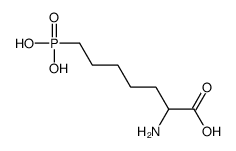DL-AP7

DL-AP7 structure
|
Common Name | DL-AP7 | ||
|---|---|---|---|---|
| CAS Number | 85797-13-3 | Molecular Weight | 225.17900 | |
| Density | 1.39g/cm3 | Boiling Point | 480.1ºC at 760mmHg | |
| Molecular Formula | C7H16NO5P | Melting Point | N/A | |
| MSDS | USA | Flash Point | 244.2ºC | |
|
Differentiation of neurons restricts Arbovirus replication and increases expression of the alpha isoform of IRF-7.
J. Virol. 89(1) , 48-60, (2014) Susceptibility to alphavirus infection is age dependent, and host maturation is associated with decreased virus replication and less severe encephalitis. To identify factors associated with maturation-dependent restriction of virus replication, we studied AP-... |
|
|
Effect of barodenervation on cardiovascular responses elicited from the hypothalamic arcuate nucleus of the rat.
PLoS ONE 7(12) , e53111, (2012) We have previously reported that chemical stimulation of the hypothalamic arcuate nucleus (ARCN) in the rat elicited increases as well as decreases in blood pressure (BP) and sympathetic nerve activity (SNA). The type of response elicited from the ARCN (i.e.,... |
|
|
L-NOARG-induced catalepsy can be influenced by glutamatergic neurotransmission mediated by NMDA receptors in the inferior colliculus.
Behav. Brain Res. 234(2) , 149-54, (2012) The inferior colliculus (IC), a midbrain structure that processes acoustic information of aversive nature, is distinguished from other auditory nuclei in the brainstem by its connections with structures of the motor system. Recent evidence relating the IC to ... |
|
|
Brain superoxide anion formation in immature rats during seizures: protection by selected compounds.
Exp. Neurol. 233(1) , 421-9, (2012) The widely-held assumption was that oxidative stress does not occur during seizures in the immature brain. The major finding of the present study concerns evidence of oxidative stress in the brain of immature rats during seizures induced by DL-homocysteic aci... |
|
|
Effects of glutamate NMDA and TRPV1 receptor antagonists on the biphasic responses to anandamide injected into the dorsolateral periaqueductal grey of Wistar rats.
Psychopharmacology 226(3) , 579-87, (2013) The endocannabinoid and endovanniloid anandamide (AEA) exerts biphasic effects when injected into the dorsolateral periaqueductal grey (dlPAG) in rats submitted to threatening situations. Whereas lower doses of AEA induce anxiolytic-like effects by activating... |
|
|
Tegmental pedunculopontine glutamate and GABA-B synapses mediate morphine reward.
Behav. Neurosci. 123(1) , 145-55, (2009) The tegmental pedunculopontine nucleus (TPP) of the midbrain is critical in mediating the acute rewarding effects of opiates. However, the circuitry and neurochemistry underlying this effect has not been determined. Here we identify TPP receptors and cell typ... |
|
|
Involvement of glutamatergic receptors in the nucleus cuneiformis in modulating morphine-induced antinociception in rats.
Eur. J. Pain 11(8) , 855-62, (2007) The nucleus cuneiformis (CnF), located just ventrolateral to the periaqueductal gray, is part of the descending pain modulatory system. Neurons in the CnF project to medullary nucleus raphe magnus (NRM), which plays an important role on pain modulation. In th... |
|
|
Glutamatergic neurotransmission mediated by NMDA receptors in the inferior colliculus can modulate haloperidol-induced catalepsy.
Brain Res. 1349 , 41-7, (2010) The inferior colliculus (IC) is primarily involved in the processing of auditory information, but it is distinguished from other auditory nuclei in the brainstem by its connections with structures of the motor system. Functional evidence relating the IC to mo... |
|
|
Microinjection of muscimol into the periaqueductal gray suppresses cardiovascular and neuroendocrine response to air jet stress in conscious rats.
Am. J. Physiol. Regul. Integr. Comp. Physiol. 295(3) , R881-90, (2008) Microinjection of the neuronal inhibitor muscimol into the dorsomedial hypothalamus (DMH) suppresses increases in heart rate (HR), mean arterial pressure (MAP), and circulating levels of adrenocorticotropic hormone (ACTH) evoked in air jet stress in conscious... |
|
|
Allopregnanolone induces LHRH and glutamate release through NMDA receptor modulation.
Endocrine 40(1) , 21-6, (2011) LHRH release from hypothalamus is influenced by the neurotransmitter glutamate that acts, among others, on NMDA receptors present in LHRH neurons. On the other hand, the neurosteroid allopregnanolone can modulate the activity of specific neurotransmitter rece... |